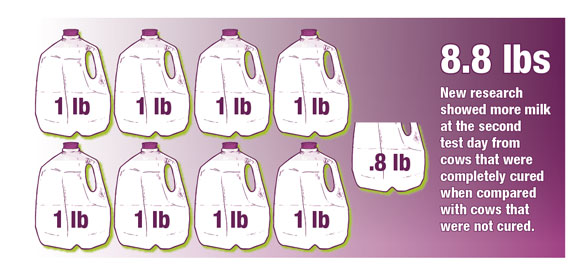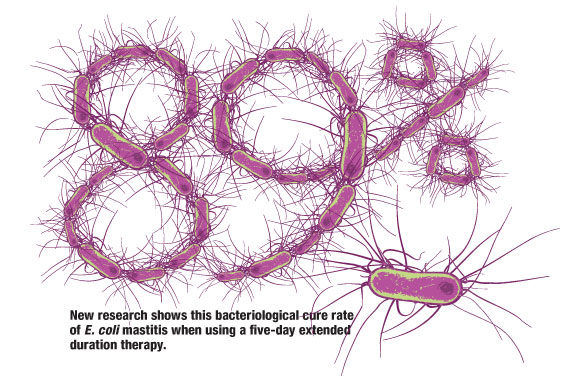For dairy cattle, routine and stability are as necessary as feed and water. Likewise, mastitis treatment protocols can become second nature on a dairy operation, remaining unchanged for years. Although stability can be good for milk quality – a consistent milking routine, for example, is vital – it is important to continually assess and adjust treatment protocols with your veterinarian based on culture records and treatment history. Occasionally, other factors come into play that require a fresh look at treatment protocols.
For example, a recent study from Cornell University is sparking a paradigm shift in how treatment protocols are developed for mild and moderate gram-negative mastitis infections.
Rethinking gram-negative mastitis
Decision trees for treatment of gram-negative mastitis historically have indicated nontreatment because it was believed that cows would self-cure or that treatment wouldn’t be successful. However, this groundbreaking research at Cornell shows that “old dogs can learn new tricks” and that gram-negative infections can be treated successfully.
The study showed a significantly higher cure rate for cows with mild or moderate Escherichia coli ( E. coli ) mastitis that received five days of intramammary treatment with Spectramast LC (ceftiofur hydrochloride) Sterile Suspension, as compared with untreated controls. (See the sidebar at the bottom for research details.)
What does this new research mean for you and your dairy operation’s mastitis management program?
Many dairy producers think of coliform mastitis as only severe in nature with fever – hot, painful udder swelling; grossly abnormal milk; lack of appetite and shock-like symptoms.
However, not all instances of gram-negative infections are severe. On many dairies, the majority of gram-negative infections present as typical, everyday, run-of-the-mill mastitis, and Cornell University researchers focused their research on the effectiveness of treating these mild and moderate gram-negative cases.
Identification protocols key to successful treatment
One key to making changes in your mastitis treatment decision trees is developing a consistent mastitis infection identification system.
Utilizing a scoring system, such as the 3-2-1 Mastitis Scoring System (endorsed by the Milk Quality and Udder Health Committee of the American Association of Bovine Practitioners), can help your employees consistently and accurately identify and classify infections and implement the appropriate treatment protocols.
• Severity Score 3 (severe clinical mastitis): Milk or gland abnormalities accompanied by signs of systemic illness, including decreased feed intake, decreased milk production, lethargy, weakness, recumbence, sunken eyes, cold extremities, low-volume diarrhea, fever, tachycardia, dehydration and reduced rumen motility.
• Severity Score 2 (moderate clinical mastitis): Visibly abnormal milk accompanied by obvious gland inflammation but no signs of systemic illness. Gland inflammation includes swelling, firmness, heat, pain or redness, with or without a mild decrease in milk production.
• Severity Score 1 (mild clinical mastitis): Systemically healthy cow with visible abnormalities in the milk and little or no evidence of gland inflammation. Visible abnormalities in the milk are a change in color (yellow, clear, bloody), viscosity (watery, thick) or consistency (flakes, clots).
• Severity Score 0 (resolved clinical mastitis): Absence of systemic illness and return to visibly normal milk following an episode of clinical mastitis. The gland may remain enlarged or firm but is not red, hot or painful.
Classifying infections is only one part of disease identification. In order to provide the best chance for a complete, or bacteriological, cure, employees must identify infections early.
As soon as signs of infection are seen in the udder, early and aggressive treatment with the proper product and for the right duration help ensure that we fight the bacteria before a more severe infection develops.
Culture programs provide valuable insights
On many dairies, gram-positive organisms may be the primary source of mastitis infections. However, without a robust culturing program in place, you might not know exactly which pathogens are infecting your cattle and you may be surprised at the results of an ongoing culture program.
Research shows that gram-negative bacteria, such as E. coli , cause 40 percent of all clinical mastitis cases.
It is important to work with your veterinarian to implement an ongoing culture program to uncover the common mastitis-causing bacteria on your dairy operation. The appropriate milk culturing program depends on the individual dairy’s parlor management system and specific milk quality goals, but a few guidelines should be followed.
• Sample clinical cases – Culture individual cows with clinical mastitis to identify pathogens present and plan treatment decisions – taking into account that gram-negative infections can be treated and cured.
• Perform periodic bulk tank sampling – Bulk tank culturing can help determine whether contagious pathogens, such as Staphylococcus aureus , Streptococcus agalactiae or Mycoplasma bovis , are present. When contagious pathogens are detected, further milk culturing and individual cow samples must be collected to develop specific treatments.
• Culture incoming cattle – When purchasing cattle, you sometimes can purchase problems. Producers should screen all incoming cows for mastitis-causing pathogens and decide on a course of action – culling or tailored treatment – based on specific pathogens identified.
Rethinking your treatment protocols and changing your perceptions of gram-negative mastitis treatment can provide more successful treatment outcomes and a renewed focus on improved milk quality.

Dispelling the myth of a self-cure
A new Cornell University study supports a new way of thinking – that antibiotic treatment of gram-negative mastitis can be successful. Specific revelations from the research include:
• For clinical mastitis caused by Escherichia Coli ( E. coli ), 89 percent of the cows treated with a five-day regimen of intramammary treatment with ceftiofur hydrochloride showed bacteriological, or complete, cures, compared with 53 percent of untreated control cows.
• Cows that were completely cured gave 8.8 more pounds of milk at the second test day when compared with cows that were not cured.
• Herd survival also was significantly higher in completely cured animals versus animals that were not cured.
Important Safety Information: Inappropriate dosage or treatment intervals for Spectramast LC or failure to adhere to proper milk discard period will result in violative milk residues. It requires a 72-hour milk discard period and a two-day pre-slaughter withdrawal period following the last treatment. As with all drugs, the product should not be used in animals found to be hypersensitive to it.
References omitted due to space but are available upon request to editor@progressivedairy.com.







